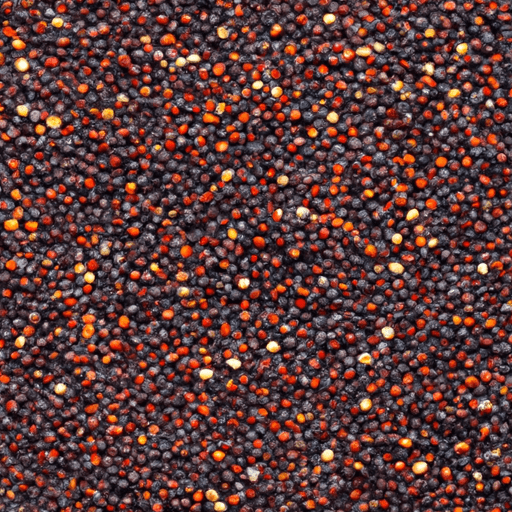All About Black Quinoa: A Delightfully Nutritious and Versatile Grain
Quinoa, the ancient grain that has gained immense popularity in recent years, is renowned for its nutritional benefits and culinary flexibility. While many are familiar with the standard white and red varieties, black quinoa is a lesser-known gem that possesses its own unique qualities and characteristics. In this post, we’ll explore the delightful world of black quinoa, delving into its taste, common uses in cooking, nutritional value, and sharing some interesting history and facts.
Unveiling the Taste and Texture
Black quinoa is visually striking, with rich, dark black seeds that retain their color even after cooking. Its flavor is nutty and earthy, with a slightly sweeter profile compared to its white and red counterparts. The texture of cooked black quinoa is wonderfully crunchy, providing a delightful contrast to a wide range of dishes.
Versatility in Cooking
Black quinoa, like other quinoa varieties, is incredibly versatile, making it a great addition to any culinary repertoire. It serves as a delightful substitute for rice or pasta and can be used in both sweet and savory recipes.
In savory dishes, black quinoa adds depth and intrigue to salads, pilafs, and grain bowls. Its vibrant color makes for visually appealing presentations, uplifting any dish it accompanies. Add cooked black quinoa to vegetable stir-fries, stuff it into bell peppers, or use it as a filling in stuffed mushrooms for an extra touch of elegance.
On the sweeter side, black quinoa can be used as a base for warm breakfast porridge or as an intriguing ingredient in baked goods like cakes, cookies, and muffins. This versatile grain lends a unique taste and texture profile to desserts that will surprise and delight your taste buds.
Nutritional Powerhouse
Beyond its culinary appeal, black quinoa is a nutritional powerhouse. It is a fantastic source of plant-based protein and dietary fiber, making it an excellent choice for vegetarians, vegans, and anyone looking to increase their nutrient intake. This grain also contains essential minerals like iron, magnesium, and phosphorus, as well as vitamins B and E.
One fascinating aspect of quinoa, including the black variety, is its status as a complete protein. This means it contains all nine essential amino acids that our bodies need to function properly. Black quinoa provides a convenient and nourishing option for those seeking a well-rounded source of amino acids without relying on animal-based proteins.
A Glimpse into History and Fun Facts
Quinoa has a rich history, dating back thousands of years to the Andean region of South America. It was a sacred crop for the Incas, who believed it to be a gift from the gods. Black quinoa, specifically, was a rarity even among the ancient Inca civilization, reserved exclusively for royalty and ceremonies.
In recent times, the demand for black quinoa has surged due to its unique aesthetic appeal, culinary versatility, and notable health benefits. This increased popularity has led to its cultivation and availability in various regions around the world.
Whether you’re a culinary adventurer seeking new flavors or a health-conscious individual looking to diversify your diet, black quinoa is an excellent choice. Its enticing taste, versatility in cooking, and impressive nutritional profile make it a worthy addition to any meal.
Next time you’re at the grocery store or browsing online, consider picking up a bag of black quinoa and let your culinary creativity soar. Your taste buds and body will thank you!
Note: Always follow the cooking instructions on the packaging for precise cooking times and ratios.
Now, get ready to explore the enchanting world of black quinoa and elevate your meals to new heights!
Black Quinoa
Origin: Quinoa (Chenopodium quinoa) is a grain crop native to the Andean region of South America, including countries such as Bolivia, Peru, and Ecuador. Black quinoa is a variety of quinoa, along with red and white quinoa. It has been cultivated for thousands of years by the indigenous peoples of the Andean highlands.
Common Uses: Like other varieties of quinoa, black quinoa is versatile and can be used in a variety of dishes. It has a slightly sweeter and nuttier flavor compared to white quinoa. It can be used as a side dish, in salads, soups, stews, and as a base for pilaf, just like other types of quinoa.
Nutritional Benefits: Black quinoa, like other quinoa varieties, is highly nutritious. It is a complete protein, containing all nine essential amino acids. It is also a good source of dietary fiber, providing about 5 grams per cooked cup. Additionally, black quinoa contains minerals such as manganese, phosphorus, magnesium, and zinc, as well as vitamins like folate and vitamin E.
Unique Properties: Black quinoa gets its dark color from pigments called anthocyanins, which are powerful antioxidants. These pigments also have anti-inflammatory properties. Black quinoa has a slightly earthier taste and a slightly crunchier texture compared to other quinoa varieties.
Historical Significance: Quinoa has been a staple food in the Andean region for thousands of years, and its cultivation dates back to pre-Columbian times. It played an essential role in the diet of the Inca civilization and was considered a sacred crop. In recent years, its popularity has spread globally due to its nutritional benefits and versatility in cooking.




Use the share button below if you liked it.
It makes me smile, when I see it.